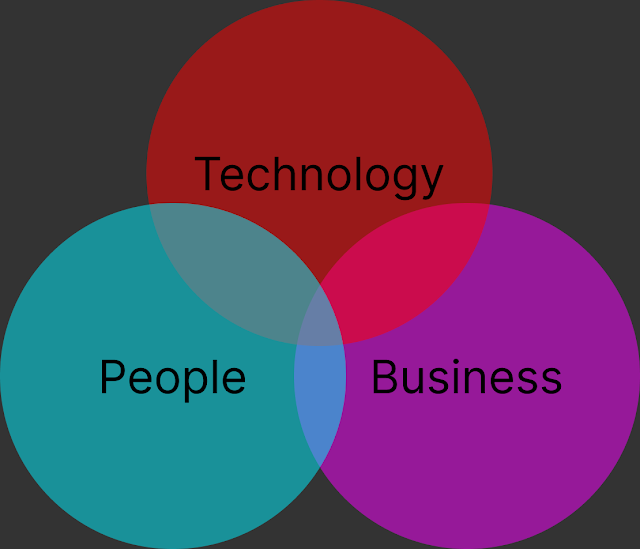Design thinking in a nutshell is a set of techniques leveraged to figure out what the right problem is before solving it; this may sound superfluous however too often in today's world symptoms are confused with causes. For example poor user adoption is not a problem, it is the symptom of an underlying problem and design thinking asks and understands the most important question.
Design thinkers are merely trying to answer why is something the way it is, before trying to come up with a solution:
- Why are we losing money?
- Why is no one using our service?
- Why is no one buying our product ?
- Why does something take so long?
- Why is information not readily available?
- Business: this perspective keeps the solution aligned with organizational goals and within budgetary confines
- People: not necessarily represented by actual users, but focused on understanding the users and their context.
- Technology: provides an understanding of what is possible, what can actually be implemented to solve the problem
States of design thinking:
Research:- Problem: this is the problem that has been presented to the Design team.
- Investigate: the design team thoroughly investigates the problem.
- Reframe: Once the team has investigated the problem, they have the knowledge and understanding reframe the problem into the root cause and not just the presenting symptoms.
The investigation of a problem revolves around the three cross functional domains:
- Users: Gain an understanding into the end users and their context, how, where and why do they need this solution.
- Business: How will this solution align with the business's strategic goals, which markets should this solution be distributed to, what type of revenue is required, what are compositors doing.
- Technology: what resources are required for this product to be successful, is the technology feasible, is it readily available,
Ideate:
The ideation state is generally what comes to mind when the words "Design thinking" are thrown about, this is the stage where the team comes up with creative solutions to the problem they're trying to solve.
- Divergent: is the concept of coming up with ideas no matter how wild or unfeasible to solve the problem.
- Convergent: narrowing down ideas to those that are feasible and best solve the problem
- Visualization/storytelling: packaging these wild ideas in such a way that there value can be communicated with a greater audience
Prototype:
The prototype state is where the team takes their best ideas and puts them to the test.
- Prototype: build a model of part or all of an idea that the team wants to verify.
- Test: create quantifiable criteria to measure prototypes against
- Refine: synthesize results from prototype testing and incorporate lessons learned back into prototypes.
Prototypes should aim to answer questions like:
- Does the solution really work the way it was intended?
- What do your users think of the solution, aesthetically, functionally?
States of design thinking
Design thinking moves between three states, in any order, generally you'd start with Research, but you could really head in any direction from there. Designing a solution involves many iterations between Research, Ideation, and prototyping as the team learns more about the problem from prototyping and/or ideating they need to revisit their problem definition do more research
Our design team has to be comfortable with ambiguity, it needs to be made up of people that have various perspective but share one very important trait, and that's curiosity, these aren't people who want to be told what to do, they are people want to figure out what to do. People who are not afraid of sharing their ideas, who welcome challenge and criticism, people who are humble who don't mind sharing a "dumb" idea who aren't afraid of being wrong and who understand that sometimes the best solutions sprout from the dumbest ideas.
To truly embody the design thinking mindset one has to be part of a team where members can riff off each others ideas. To be able to work together in a constructive way to look at a problem holistically and iterate one their own as well as each others ideas. To have an open minded team spirited decentralized approach to problem solving, where everyone contributes and no one steals the show. Design thinking isn't about a superstar solving a problem it's about a team of passionate individuals drawing on each others expertise to identify problem and propose a holistic solution.
The Design team keeps the "User" at the center of their solution realizing that they are solving a business problem for a group of users leveraging technology.
the design process has three main bi-directional stages. the process is very iterative, we can identify our opportunity design our approach, go back rethink our opportunity then jump to our prototype, test it than redesign, prototype again and just move between the phases as needed to try and frame our problem and a solution that meets our main criteria.
In short Design thinking is a safe space for curious minds to come up with viable, novel, and desirable solutions.





